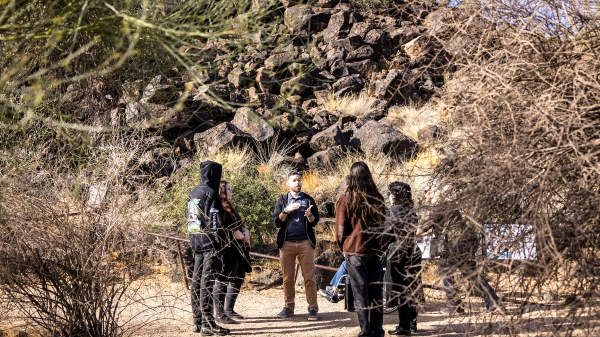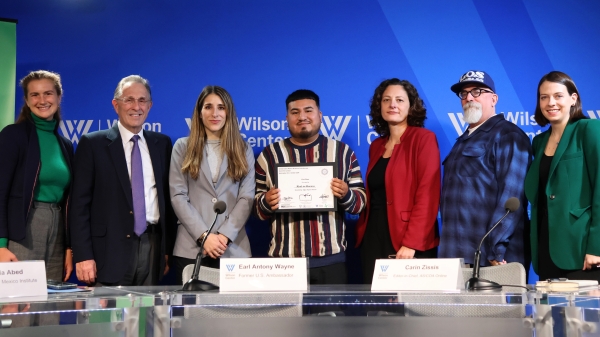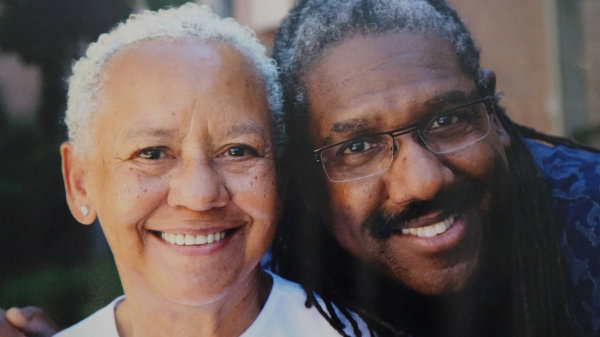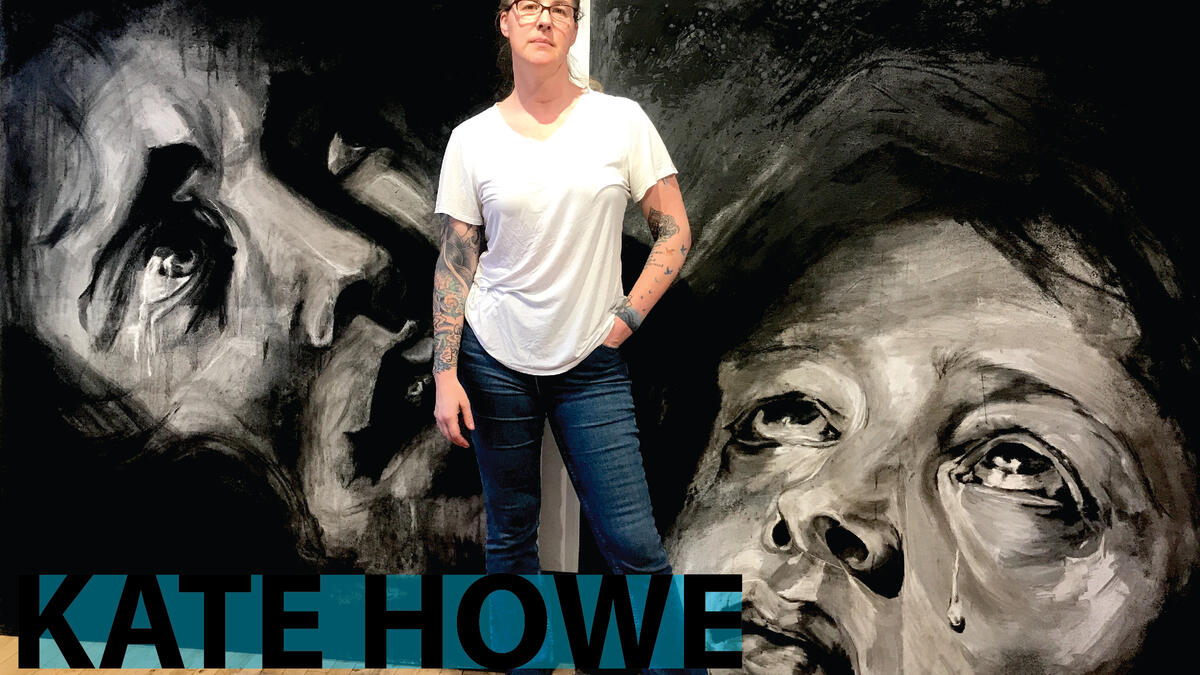Editor's note: This story is part of a series of profiles of notable spring 2020 graduates.
Kate Howe’s path to becoming an ASU alumna has been somewhat unconventional, but that’s what makes the destination even more rewarding for this Colorado-based visual artist.
Her passion for self-expression began early on. She spent her childhood in art museums marveling with her mother, also an artist, at the masterpieces displayed in their halls. A love for the arts has been a constant in Howe’s life, but personal roadblocks temporarily sidelined her plan to follow in her mother’s footsteps and translate her creativity into a career.
After she was diagnosed with breast cancer in 2017, she had to choose between letting it hold her back or using it as an opportunity to get back to her artistic roots. She ultimately decided to pursue a degree in art history so she could eventually return to the studio when she recovered from cancer treatment.
As for why she picked ASU Online to further her education, her reasoning was twofold. “Because Dustin Pedroia — my favorite Red Sox player — was a Sun Devil, and it turns out we have the best online art history program in the country,” Howe said.
Howe’s decision to improve her life is paying off this May as she graduates with her Bachelor of Arts in art history from ASU’s Herberger Institute for Design and the Arts. Along with being an artist, full-time online student and mother to two teenage boys, Howe is also a climate and sustainability activist whose commitment to conservation is evident in everything she touches.
A recent example is a billboard she created for Aspen’s Imagine Climate initiative earlier this year using pens filled with a new type of ink made from carbon emissions. Howe’s design was partly influenced by her sons’ feelings of fear and frustration about the current state of the global climate. But she also drew on the techniques she studied in the art history program at ASU, particularly those of Renaissance painters. The goal was simple: to make an impact in her community by creating a thought-provoking piece in a unique format.
“We need to make sure we are using this medium in a way that helps us make whatever small changes we're capable of making,” she said, “or just stops us enough to say, ‘What am I doing? What can I do differently?’” The billboard later sold for $10,000 and is now installed at the Aspen Art Museum.
These days, COVID-19 has forced Howe to become more isolated in her practice. But she’s leveraging the long days spent at home to make even bolder artistic choices.
“Just because I’m in lockdown doesn’t mean I can’t innovate. I use this silence and time to try things in my art that will most likely fail,” she said. “This is a good time to take risks in art and to push my practice forward in solitude.”
Howe isn’t taking much of a break between graduation and embarking on her next adventure: earning her Master of Fine Arts in painting with the Royal College of Art in London later this summer. And as for the long term, Howe isn’t concerned about the common misconception of the struggling artist.
“When people ask me how I’m going to make a living making art, I just say, ‘I’m working on it.’ I have been discouraged from being a fine artist my whole life because it’s like being an Olympic athlete — many compete but few land on the Wheaties box,” she said.
“But the Wheaties box is not the only way to earn an income. It’s not all or nothing. There are huge opportunities all over the arts. You don’t have to pick a job off a list anymore. Be who you are — be relentless — and you will end up making money in a job you love. Obstacles are just opportunities; they are nothing but puzzles to solve.”
Keep reading below for more about Howe’s journey to becoming an ASU alumna and her empowering message to fellow Sun Devils. Also be sure to visit her website to stay updated on her latest projects.
Question: What was your “aha” moment when you realized you wanted to study the field you majored in?
Answer: Lying in bed recovering from cancer treatment, I knew I couldn’t go back to school for studio art. There's no school near me, and I was bedridden. What could I do from bed that would be intellectually stimulating and set me up to step back into the studio, more well-armed to make the kind of impactful art I want to make? “Aha! Art history! If I have a good, deep knowledge of history, I can build on it and make informed choices in my own work. Why, it would almost be like cheating! I’ll look at and do a deep dive in art for two years and then go to grad school for studio art.”
Q: What’s something you learned while at ASU — in the classroom or otherwise — that surprised you or changed your perspective?
A: I had no idea that the history of art, like this history of everything, is written and collected by the victors. I didn’t know what feminist art theory was, and I had no idea that it was OK to be a feminist. Because I was born in 1971, I was complicit in benevolent sexism. I learned that I had a voice, that it was OK that that voice was gendered should I choose it to be, and that it was OK to have strength and boundaries about genderism.
Q: Which professor taught you the most important lesson while at ASU?
A: Betsy Fahlman taught me to look deeper at almost everything, and Mako Fitts Ward taught me what gender was. Together, they made me into a new artist.
Q: What’s the best piece of advice you’d give to those still in school?
A: When you are overloaded and becoming avoidant, stand outside in the sun for a minute. Make a cup of tea or something soothing, then turn your face to the task at hand and get to work. Do what you can with the time you have, and when you think you don’t have time, cut something out and focus on school. This matters. This is hard to do when you are older. Rather than adding to your suffering by wishing you didn’t have to tackle whatever the project is, recognize you are adding greatly to your suffering by wishing. Quit your wishin’ and get to work. You can do this! If I can, anyone can.
Q: What was your favorite spot for power studying?
A: I spent most of the last three years in bed, which I call my spaceship when it's set up for studying. Surrounded by my sketchbook (because almost everything I read gives me ideas for work I want to make in my own studio), healthy snacks (because I learned the hard way that sugar and caffeine make you feel sick if you have too much of them), textbooks, printouts, notes, reference books, my computer and my cat, with a nice candle burning (I live in the woods in a very cold cabin). I would fly my spaceship into art history land and park it there. That’s my favorite place.
Q: What are your plans after graduation?
A: I was accepted to the Royal College of Art in London for graduate studies in painting! My whole family, my two teenage sons and my partner and I will be relocating to London (conditions permitting) in August 2020!
Q: If someone gave you $40 million to solve one problem on our planet, what would you tackle?
A: I would tackle human equality across genders and races and nationalisms, religions and all ideologies. First, we have to work together if we are going to keep flying around on Spaceship Earth. It’s the only home we have, and we need to learn to leave space for others to be right even when we are sure they are wrong. Hopefully the COVID-19 era will be the closing chapter to everyone’s 15 minutes of influencer fame, name calling and hate speech being modeled by our leaders and the valuing of money over human life, and will usher in a new era of compassion and cooperation, with politics led by science, critical thinking and forward thinking.
More Arts, humanities and education

Petroglyph preserve celebrates 30th anniversary with ancient, modern tales
The Deer Valley Petroglyph Preserve provides a beautiful walk through a pristine desert where chuckwalla lizards are as plentiful…

Kaleidoscope short film contest inspires powerful binational filmmaking in its second year
“We come to this country not to steal anybody’s jobs but to take advantage of the opportunities that the rest ignore. We’ve been…

ASU's Neal Lester reflects on life, death of poet Nikki Giovanni
When Neal Lester heard on Monday that poet and activist Nikki Giovanni had died, the news hit hard.Lester, the founding director…
